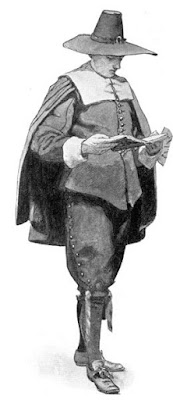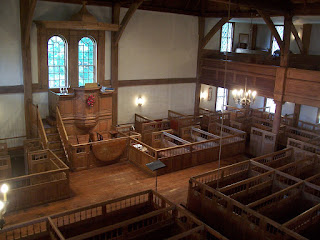"Hobgoblin nor foul fiend, can daunt his spirit
He knows he at the end, shall life inherit
Then fancies fly away, he’ll fear not what men say
He’ll labour night and day, to be a pilgrim."
The last verse of this rousing Church of England hymn
typifies the muscular Christian strand. The sincerity of John Bunyan’s 1684
words leaves the easy-going path for a more adventurous one, though mention of
hobgoblins and fiends plus the whiff of self-righteousness may sit uneasily
today. But these beliefs were widespread in the 17th century,
driving English politics and the settlement of America.
Politics and the Reformation
Rise of Puritanism
These ‘Puritans’ (originally a pejorative term) aimed
to purify the Church of England of Catholic practices. They wanted a simpler
form of worship and doctrine, and believed in corporate and personal piety. Never
a formally defined version of Protestantism, the principally Calvinist culture spanned
a wide spectrum between moderates and extremists. Puritans saw the Elizabethan
settlement as just a first step - remain with the Church of England and reform
it from within.
The ‘Pilgrims’ (the term was not used for the emigrant Plymouth Colony group until the 19th century - their leader, Bradford, never heard the word in his lifetime), were Separatists. They were
Calvinist Puritans who felt their beliefs so strongly that they could not
follow them within the English church. There were pockets of them in the north
and east of England. Not tolerated under Elizabeth or James, in 1607 a group
left for Leiden in Holland. Many found it hard to learn Dutch and prosper
there. Spain was threatening to grab more Dutch territory and some of the group
haplessly got mixed up with religious unrest in Scotland. So in 1618 most
decided to depart for a fresh start in America.
'Pilgrim Fathers' (or Forefathers)
In 1620 they left from Plymouth on the Mayflower, eventually
mooring off what is now Provincetown at the tip of Cape Cod - the second
English American settlement after Jamestown, Virginia in 1607. Half of them died
on the ship or soon after arrival. Once ashore they found a European hut and kettle
- in case they fancied a cuppa? Some land had been cleared, but not being a
practical bunch, they relied on the local Wampanoag people, one of whom had
spent years in London and spoke English, to show them how to fish and grow
food. Indeed at the start they respected the locals, who made up two thirds of
the crowd at the fabled 1621 harvest feast, the basis of today’s Thanksgiving.
Interior of Old Ship Church, Hingham, Mass.
Their charter from London was not signed before departure. As they had no patent, a document later called the Mayflower Compact was drafted. Revered by some American historians, it promised cooperation ‘for the general good of the Colony’. Issues would be decided by voting. The Plymouth Rock document is now widely seen as one of the seeds of American democracy. But perhaps we'd better not try to stray too far into the myths of American history.So what were these people like? The Separatists (or
forefathers as they were called in America), and their European counterparts, wore
colourful clothes, rather against popular belief. They tended to be poorer than
mainstream Puritans and less well educated. They usually ended up on the
outside of society. But they were tolerant of others’ beliefs. Puritans, though,
especially the better off ones, usually favoured black hats and dark colours. With their
‘City on a Hill’ they were intolerant of other views, sharing a divinely
ordained arrogance, and explicitly rejecting religious freedom. They also believed
literally and actively in devils and demons.
Puritan power
In England, Puritan influence grew from 1630 as
Charles I began ruling without Parliament. Puritanism offered a way to cope
with the contradictory demands of Christian belief in a modernising world. A
Puritan group launched a well-financed venture, the Massachusetts Bay Colony,
in 1630. It was seen as a sound investment opportunity, with earthly prosperity
a sign of divine approval. In 1629, pre departure, they designed a colony seal
justifying the settlement - a nearly naked Indian, begging the English to ‘come
over and help us’.
Within 10 years the Mass Bay group, centred in Boston, had grown to 20,000 settlers. They thrived as Plymouth wilted. Within 30 years they had basically taken over the 1620 colony. Independent of the Church of England in practice, they acted like Presbyterians, as did the Separatists. Puritan ethics of charity and self-discipline seemed well suited to a New World where opportunity was rich but the source of moral authority obscure. In current English usage, ‘puritanical’ often denotes prudery and aversion to sex. Yet these Puritans embraced sexuality, at least within marriage. Their birth rate was high - as remarked at the time, every family seemed to have 10 children.
At home, as part of the new commercial culture and as allies of the Scottish Presbyterians, Puritans became powerful in English politics. They were strongly represented in Parliament and played a major role in both the Civil War and during the Commonwealth and Protectorate. Many were prominent in several fields from business to education.
Legacy
The Restoration and 1662 Uniformity Act required all clergy to sign a new oath and follow the revised Book of Common Prayer, so almost all Puritan clergy then left the Church of England. The episode, called the Great Ejection, excluded huge numbers of people from public office. A few of the clergy went to America, but most continued in nonconformist denominations, especially Congregational and Presbyterian churches. Some Puritan ideals were absorbed by the Church of England, while others grew into new Protestant offshoots. Today’s Congregationalists are widely recognised as the direct inheritors of the Puritan tradition.
Puritanism as a force then died out fairly quickly in England. As a power it was gone by the end of the 17th century, though of course it continued strongly in America for much longer. Indeed its legacy remains a key factor in US political, social and commercial life today.





No comments:
Post a Comment